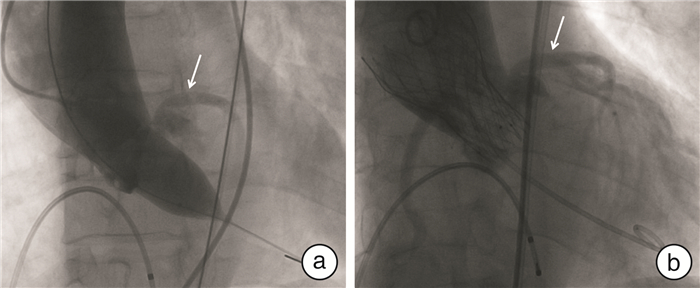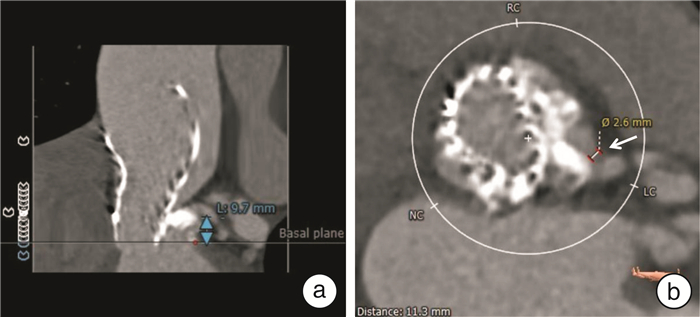Application of 3D printing in the risk assessment of coronary artery obstruction before transcatheter aortic valve replacement: a case report
-
摘要: 冠状动脉阻塞是经导管主动脉瓣置换术(transcatheter aortic valve replacement,TAVR)少见却致命的并发症,然而尚无公认的标准方案应用于此并发症的风险评估。目前, 针对TAVR冠状动脉阻塞风险评估最常用的方法是通过影像学直接评估, 但是瓣膜部署后钙化团块的真实偏转情况很难被精确预测。因此, 该风险评估可能受到经验主义的影响, 从而导致评估结果出现偏差。本文报道TAVR术前应用3D打印技术精确评估冠状动脉阻塞风险1例, 为临床诊治提供经验参考。
-
关键词:
- 3D打印 /
- 经导管主动脉瓣置换术 /
- 冠状动脉阻塞
Abstract: Coronary artery obstruction is a rare but fatal complication of transcatheter aortic valve replacement(TAVR). Experts have summarized and approved the related prevention strategies, yet there are no accepted criteria to evaluate the occurrence of coronary artery obstruction accurately. The most common method for the risk assessment of coronary artery obstruction before TAVR is direct imaging assessment. However, the actual deflection of the calcium deposits towards the coronary ostia during valve deployment is difficult to predict precisely. Therefore, the risk assessment may be influenced by empiricism, which may lead to a biased result. This paper reports a case of accurate evaluation of coronary artery obstruction risk by 3D printing before TAVR, providing a reference for clinical diagnosis and treatment strategy in similar cases. -

-
-
[1] 周达新, 潘文志, 吴永健, 等. 经导管主动脉瓣置换术中国专家共识(2020更新版)[J]. 中国介入心脏病学杂志, 2020, 28(6): 301-309. https://www.cnki.com.cn/Article/CJFDTOTAL-ZJXB202006001.htm
[2] 祝磊, 欧袁伟翔, 李茜, 等. 经导管主动脉瓣置换术并发冠状动脉阻塞的研究进展[J]. 华西医学, 2020, 35(9): 1039-1043. https://www.cnki.com.cn/Article/CJFDTOTAL-HXYX202009005.htm
[3] Liu JD, Luo XD, Zhou ZP, et al. Annular and supra-annular structure assessments for transcatheter aortic valve replacement in patients with bicuspid aortic stenosis[J]. Rev Cardiovasc Med, 2021, 22(4): 1157-1166. doi: 10.31083/j.rcm2204124
[4] Kapadia SR, Leon MB, Makkar RR, et al. 5-year outcomes of transcatheter aortic valve replacement compared with standard treatment for patients with inoperable aortic stenosis(PARTNER 1): a randomised controlled trial[J]. Lancet, 2015, 385(9986): 2485-2491. doi: 10.1016/S0140-6736(15)60290-2
[5] Mack MJ, Leon MB, Thourani VH, et al. Transcatheter Aortic-Valve Replacement with a Balloon-Expandable Valve in Low-Risk Patients[J]. N Engl J Med, 2019, 380(18): 1695-1705. doi: 10.1056/NEJMoa1814052
[6] Kodali S, Pibarot P, Douglas PS, et al. Paravalvular regurgitation after transcatheter aortic valve replacement with the Edwards sapien valve in the PARTNER trial: characterizing patients and impact on outcomes[J]. Eur Heart J, 2015, 36(7): 449-456. doi: 10.1093/eurheartj/ehu384
[7] Hansson NC, Grove EL, Andersen HR, et al. Transcatheter Aortic Valve Thrombosis: Incidence, Predisposing Factors, and Clinical Implications[J]. J Am Coll Cardiol, 2016, 68(19): 2059-2069. doi: 10.1016/j.jacc.2016.08.010
[8] Ribeiro HB, Rodés-Cabau J, Blanke P, et al. Incidence, predictors, and clinical outcomes of coronary obstruction following transcatheter aortic valve replacement for degenerative bioprosthetic surgical valves: insights from the VIVID registry[J]. Eur Heart J, 2018, 39(8): 687-695. doi: 10.1093/eurheartj/ehx455
[9] Ribeiro HB, Webb JG, Makkar RR, et al. Predictive factors, management, and clinical outcomes of coronary obstruction following transcatheter aortic valve implantation: insights from a large multicenter registry[J]. J Am Coll Cardiol, 2013, 62(17): 1552-1562. doi: 10.1016/j.jacc.2013.07.040
[10] Arai T, Lefèvre T, Hovasse T, et al. Incidence and predictors of coronary obstruction following transcatheter aortic valve implantation in the real world[J]. Catheter Cardiovasc Interv, 2017, 90(7): 1192-1197. doi: 10.1002/ccd.26982
[11] Webb JG, Chandavimol M, Thompson CR, et al. Percutaneous aortic valve implantation retrograde from the femoral artery[J]. Circulation, 2006, 113(6): 842-850. doi: 10.1161/CIRCULATIONAHA.105.582882
[12] Fetahovic T, Hayman S, Cox S, et al. The Prophylactic Chimney Snorkel Technique for the Prevention of Acute Coronary Occlusion in High Risk for Coronary Obstruction Transcatheter Aortic Valve Replacement/Implantation Cases[J]. Heart Lung Circ, 2019, 28(10): e126-e130. doi: 10.1016/j.hlc.2019.04.009
[13] Rivard AL, Bartel T, Bianco RW, et al. Evaluation of aortic root and valve calcifications by multi-detector computed tomography[J]. J Heart Valve Dis, 2009, 18(6): 662-670.
[14] Ribeiro HB, Nombela-Franco L, Urena M, et al. Coronary obstruction following transcatheter aortic valve implantation: a systematic review[J]. JACC Cardiovasc Interv, 2013, 6(5): 452-461. doi: 10.1016/j.jcin.2012.11.014
[15] Spina R, Khalique O, George I, et al. Acute left main stem coronary occlusion following transcatheter aortic valve replacement in a patient without recognized coronary obstruction risk factors: a case report[J]. Eur Heart J Case Rep, 2018, 2(4): yty112.
[16] 陈强, 姜益, 郝军军, 等. 3D打印技术在经导管主动脉瓣置换手术中应用价值分析[J]. 临床军医杂志, 2021, 49(11): 1244-1247. https://www.cnki.com.cn/Article/CJFDTOTAL-JYGZ202111021.htm
[17] Maragiannis D, Jackson MS, Igo SR, et al. Replicating Patient-Specific Severe Aortic Valve Stenosis With Functional 3D Modeling[J]. Circ Cardiovasc Imaging, 2015, 8(10): e003626. doi: 10.1161/CIRCIMAGING.115.003626
[18] Thériault-Lauzier P, Messika-Zeitoun D, Piazza N. Patient-Specific Computer Simulation in TAVR: Will the Technology Gain Widespread Adoption?[J]. JACC Cardiovasc Interv, 2020, 13(15): 1813-1815. doi: 10.1016/j.jcin.2020.05.021
-





 下载:
下载:


